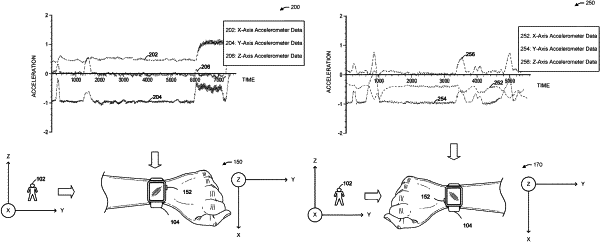| CPC G01P 13/00 (2013.01) [G01P 15/08 (2013.01); H04B 1/385 (2013.01); H04L 67/535 (2022.05); H04S 7/303 (2013.01)] | 20 Claims |

|
1. A method for determining a device orientation, the method comprising:
determining, by at least one processor of a wearable device, first data indicative of motion associated with a user;
determining, by the at least one processor, based on the first data, that the motion is associated with walking or running at a first time;
determining, by the at least one processor, based on the motion being associated with walking or running at the first time, accelerometer data detected by an accelerometer of the wearable device during a time period beginning at the first time and ending at a second time after the first time;
determining, by the at least one processor, first accelerometer data of the accelerometer data, the first accelerometer data associated with a first axis parallel to the ground;
determining, by the at least one processor, second accelerometer data of the accelerometer data, the second accelerometer data associated with a second axis perpendicular to the first axis;
determining, by the at least one processor, a first mean acceleration value based on the first accelerometer data;
determining, by the at least one processor, a second mean acceleration value based on the second accelerometer data;
determining, by the at least one processor, that the first mean acceleration value has a positive or negative sign and that the second mean acceleration value has positive or negative sign;
determining, by the at least one processor, a button orientation of respective button orientations based on a combination of the positive or negative sign of the first mean acceleration value associated with the first axis and the positive or negative sign of the second mean acceleration value associated with the second axis,
the respective button orientations including:
a button of the wearable device being more proximal to a hand of a right arm or a left arm, or to an elbow of the right arm or the left arm; and
sending, by the at least one processor, an indication of the orientation to an application of the wearable device.
|